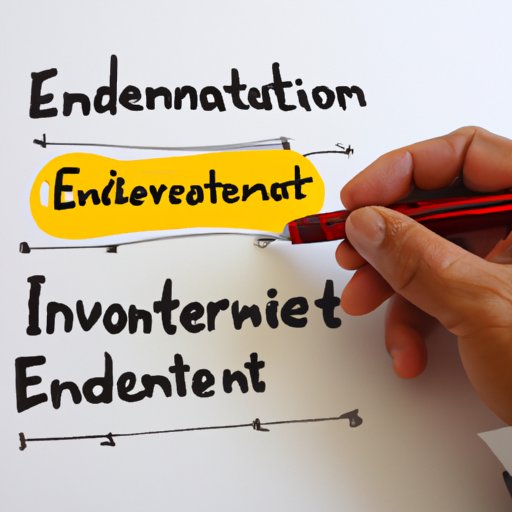Introduction
An endowment is a sum of money that is invested by an individual or organization for the purpose of generating income. Endowments are typically established to help fund specific causes, such as scholarships, research projects, or charitable organizations. Endowments are often funded through donations from individuals, corporations, or foundations and can provide a long-term source of income for the cause they support.
This article provides an overview of the costs associated with starting an endowment. We will discuss the various fees and expenses associated with creating an endowment, as well as strategies for minimizing these costs. We will also provide a comprehensive guide to setting up an endowment fund and calculating the expense associated with establishing one.
Breaking Down the Costs of Creating an Endowment
Creating an endowment involves several fees and expenses. These include legal and administrative fees, investment advisor fees, custodial fees, and fundraising expenses. Let’s take a look at each of these in more detail.
Legal and Administrative Fees
The legal and administrative costs associated with setting up an endowment can vary depending on the size of the endowment and the complexity of the structure. Generally, these costs include fees for setting up the endowment agreement, filing paperwork with the state, and obtaining any necessary licenses. Additionally, there may be ongoing administrative costs related to managing the endowment.
Investment Advisor Fees
In order to ensure that the endowment is managed properly, it is important to select an experienced investment advisor. Investment advisor fees can range from 0.25% to 2.00% of the endowment’s assets, depending on the size of the endowment and the complexity of the investments. It is important to compare fees from different advisors to ensure you are getting the best value for your money.
Custodial Fees
A custodian is responsible for holding and safeguarding the endowment’s assets. Custodial fees can range from 0.10% to 1.00% of the endowment’s assets, depending on the size of the endowment and the type of assets being held. The custodian may also charge additional fees for services such as trading, processing transactions, and providing reports.
Fundraising Expenses
It is not uncommon for endowments to rely heavily on donations from individuals, corporations, or foundations. Fundraising expenses can include advertising, marketing materials, and travel expenses associated with meeting potential donors. Additionally, some organizations may choose to hire professional fundraisers to solicit donations.
A Comprehensive Guide to Setting Up an Endowment Fund
Establishing an endowment fund is a complex process. To ensure that the endowment is set up in a way that meets the needs of the organization, it is important to follow a few key steps.
Researching Potential Investment Options
The first step in setting up an endowment is to research potential investment options. This includes evaluating stocks, bonds, mutual funds, and other types of investments to determine which ones are most appropriate for the endowment. It is important to consider factors such as risk tolerance, expected rate of return, and liquidity when making this decision.
Determining the Size of the Endowment
Once the desired investment options have been identified, the next step is to determine the size of the endowment. This will depend on the amount of money available for the endowment and the expected rate of return. It is important to balance the need for income with the need for growth when determining the size of the endowment.
Choosing a Custodian for the Endowment
The custodian is responsible for holding and safeguarding the endowment’s assets. It is important to select a reputable custodian who is experienced in managing endowments. It is also important to compare fees and services offered by different custodians to ensure you are getting the best value for your money.
Finding the Right Legal and Administrative Help
The legal and administrative aspects of setting up an endowment can be complex. It is important to find experienced professionals who can help with the setup process. This includes attorneys, accountants, and other financial professionals who can ensure that the endowment is set up correctly.
Establishing a Fundraising Strategy
It is important to develop a plan for raising funds for the endowment. This may involve soliciting donations from individuals, corporations, or foundations. It is also important to consider what incentives you can offer potential donors to encourage them to contribute to the endowment.

Estimating the Expense of Starting an Endowment
The cost of starting an endowment can vary significantly depending on the size of the endowment and the complexity of the structure. Factors such as legal and administrative fees, investment advisor fees, custodial fees, and fundraising expenses can all influence the overall cost of the endowment.
Factors that Influence Cost
There are several factors that can influence the cost of setting up an endowment. These include the size of the endowment, the complexity of the structure, the type of investments selected, and the amount of fundraising needed. Additionally, the cost of legal and administrative services, investment advisors, and custodians can all affect the total cost of the endowment.
Minimizing Costs
There are a few strategies for minimizing the cost of setting up an endowment. For example, it is important to shop around for legal and administrative help to ensure you are getting the best value for your money. Additionally, it is important to research potential investments to ensure that they are suitable for the endowment and that they are priced competitively. Finally, fundraising expenses can be minimized by focusing on low-cost strategies such as social media campaigns and word-of-mouth referrals.

Calculating the Cost of Establishing an Endowment
Once the legal and administrative fees, investment advisor fees, custodial fees, and fundraising expenses have been determined, it is possible to calculate the total cost of establishing an endowment. This includes both start-up costs, such as legal and administrative fees, and ongoing costs, such as investment advisor fees and custodial fees.
Estimating Start-Up Costs
Start-up costs for an endowment include legal and administrative fees, as well as any other expenses associated with setting up the endowment. These costs should be estimated based on the size and complexity of the endowment. Additionally, it is important to factor in any one-time fees, such as filing fees and licensing fees.
Calculating Ongoing Expenses
Ongoing expenses for an endowment include investment advisor fees, custodial fees, and any other recurring costs associated with managing the endowment. These costs should be calculated based on the size of the endowment and the type of investments selected. Additionally, it is important to factor in any additional fees charged by the custodian.

Estimating the Investment Required for an Endowment
It is important to estimate the amount of money required to establish an endowment. This includes both the initial investment required to set up the endowment, as well as any contributions needed to maintain the endowment over time. Additionally, it is important to assess the endowment’s earning potential and determine the rate of return.
Assessing the Endowment’s Earning Potential
When estimating the amount of money needed to set up an endowment, it is important to consider the endowment’s earning potential. This means assessing the expected rate of return for the investments selected and determining how much money the endowment can generate over time. It is important to consider both short-term and long-term returns when assessing an endowment’s earning potential.
Determining the Rate of Return
The rate of return is an important consideration when setting up an endowment. It is important to determine the expected rate of return for the investments selected and calculate the amount of money the endowment can generate over time. Additionally, it is important to consider the risks associated with the investments and ensure that the endowment is adequately diversified.
What is the Price Tag for Starting an Endowment?
The cost of setting up an endowment can vary significantly depending on the size of the endowment and the complexity of the structure. Legal and administrative fees, investment advisor fees, custodial fees, and fundraising expenses can all influence the cost of the endowment. Additionally, it is important to consider the amount of money required to set up the endowment and the expected rate of return.
Summarizing Costs
The cost of setting up an endowment can range from a few hundred dollars to thousands of dollars, depending on the size of the endowment and the complexity of the structure. It is important to factor in legal and administrative fees, investment advisor fees, custodial fees, and fundraising expenses when calculating the cost of the endowment. Additionally, it is important to estimate the amount of money required to set up the endowment and determine the expected rate of return.
Considering Alternative Investments
For those looking for lower-cost alternatives to setting up an endowment, there are other options available. These include mutual funds, exchange-traded funds, and other types of investments. These investments can offer similar benefits to endowments, such as tax advantages and long-term growth potential, but without the associated costs.
Conclusion
Creating an endowment is a complex and expensive process. This article has provided an overview of the costs associated with setting up an endowment, as well as a comprehensive guide to establishing an endowment fund. Additionally, we discussed strategies for minimizing costs and calculating the expense associated with establishing an endowment. Finally, we discussed alternative investments that may offer similar benefits to endowments without the associated costs.
(Note: Is this article not meeting your expectations? Do you have knowledge or insights to share? Unlock new opportunities and expand your reach by joining our authors team. Click Registration to join us and share your expertise with our readers.)
